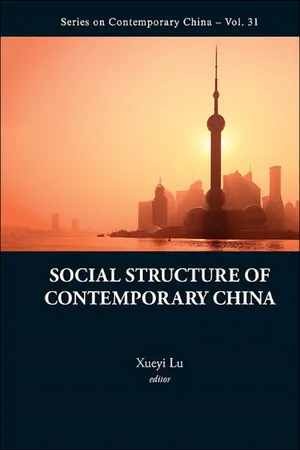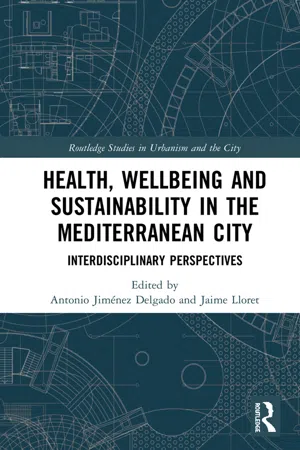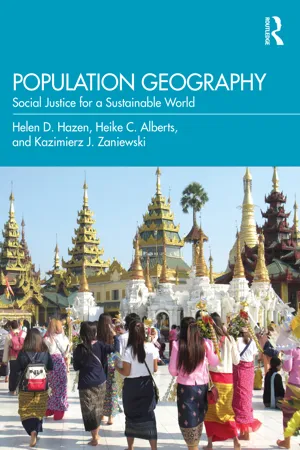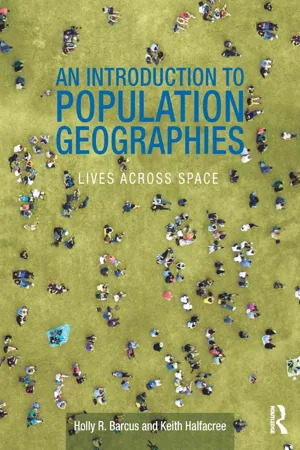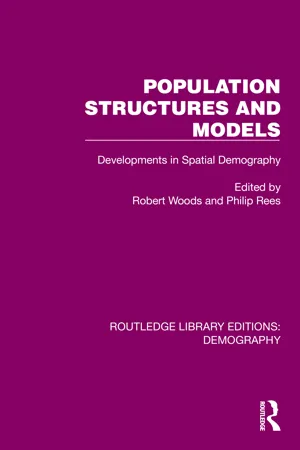Geography
Population Structure
Population structure refers to the composition of a population in terms of age, sex, and other demographic characteristics. It provides insights into the distribution of different age groups and genders within a population. Understanding population structure is crucial for assessing social and economic trends, planning healthcare and education services, and predicting future population changes.
Written by Perlego with AI-assistance
Related key terms
Related key terms
1 of 4
Related key terms
1 of 3
10 Key excerpts on "Population Structure"
- eBook - ePub
- Xueyi Lu(Author)
- 2012(Publication Date)
- WSPC(Publisher)
CHAPTER I
Population Structure
Yan YeHuman beings are the fundamental components of society and the essential carriers for resources and opportunities. The foundation of a country’s society is directly related to the population size and social status. Population Structure refers to the proportional relationship among different properties or elements within a population in a certain geographical region during a given period of time. From a social structure perspective, Population Structure reflects the allocation of resources and opportunities in terms of population characteristics. Generally, a reasonable Population Structure suits the development of productive social forces; in essence, this is a matter of the Marxist concept of adaptation between the productive forces and the productive relations.1.Profound Changes in Population Structure and Their Social Causes
1.1.Adult-Age Population Structure and Abnormal Sex Composition
Compared to 1953, with respect to the changes in age structure, the Chinese population in 2008 was characterized as follows: the proportion of the elderly population aged 65 and over increased by 88.2%; the proportion of the working population increased by 30.5%; and the proportion of children in the population declined by 56.1%, resulting in a 52.8% decrease in the gross dependency ratio, which is currently lower than 40%. In general, the Chinese population is aging, but since the working population is in its “golden age,” the age structure is in an “adult-form.”In terms of the sex composition of the population, since 1964, the sex ratio has generally fluctuated within a reasonable range of 103–107. As a result of the accelerated aging process, the sex ratio should have declined continuously and substantially. However, the extent of the decrease was relatively small (dispersion is still close to 1). The main reason for this trend is the high sex ratio at birth for the age group of 0–4-year-olds, which has led to an overall abnormal sex composition. - eBook - ePub
Health, Wellbeing and Sustainability in the Mediterranean City
Interdisciplinary Perspectives
- Antonio Jiménez-Delgado, Jaime Lloret(Authors)
- 2019(Publication Date)
- Routledge(Publisher)
This chapter showed a practical example of a basic sociodemographic diagnosis. The classification of this data has been made from four sets or dimensions of human life in a specific territory. On the one hand, it is necessary to know what are the Population Structures that exist in the municipality as a whole, and as far as possible in each social or geographical space. This is important because it allows us to know basic characteristics of the population such as sex, age or origin. In addition, it allows us to know how this structure has evolved over the years. Any design of public policies, as well as any possible intervention in a specific region, must be taken in account to obtain data for a plan of action that is coherent with the sociodemographic reality of the place.Secondly, attention has been paid to the presence of housing in the territory. In this section, a double reading should be considered, since on the one hand they can be interpreted as a configuration of the physical space or the projection of a general plan, and on the other hand they should also be considered from their social component. In this sense, it is important to highlight aspects that refer to the composition of households as well as the distribution in the territory of different socio-economic profiles and social phenomena that occur in the relationship between social and physical space. Examples are spatial segregation, empty housing, urban sprawl or gentrification processes. These dynamics can be observed and analysed from the data of these dimensions, especially when they are supported by a census or by a research representative of the region’s general configuration.The third block that has been presented refers to education and health issues. Aspects such as dependence levels, the most common diseases and the educational levels of the population allow us to observe and analyse the basic needs of the region, both social and physical. This last aspect allows us to draw a link between training and income level and to know habitual or unequal situations from different socio-economic profiles. The analysis of the evolution of the indicators in these dimensions also allows us to evaluate public policies and to know significant contexts that could have a certain predictive character. - eBook - ePub
Population Geography
Social Justice for a Sustainable World
- Helen D. Hazen, Heike C. Alberts, Kazimierz J. Zaniewski(Authors)
- 2023(Publication Date)
- Routledge(Publisher)
digital nomads —people who work remotely from coffee shops, co-working spaces, recreational vehicles, and even abroad—has been increasing for some time. Their numbers thus far are too small to amount to a significant population shift but may lead to meaningful population redistributions in the long term. These movements are also important beyond the small number of people involved because they highlight significant inequalities among population groups, with stark divides emerging between those who are able to work remotely and those who cannot and between those who have the economic means to seek out desirable locations and those who do not. These shifts also contribute to important changes in population composition, as booming towns receive an influx of economically successful professional workers, whereas declining industrial areas are left with poorer, less skilled, and older populations. Aspects such as this help illustrate why the composition of population is such an important issue—it is to this topic that we turn next.PART II: POPULATION COMPOSITION
Population geographers commonly study age, sex, and ethnic/racial compositions of populations, but many other population characteristics can be considered, including religion, language, and socio-economic status, or even literacy rates and access to clean water. Knowledge about population composition is not just an academic exercise but can also point to real-world problems such as a shortage of schools or inadequate sanitation. In the remainder of this chapter we explore age, sex/gender, and ethnicity/race as primary characteristics of population composition.Age structure
Age structure provides important information about the characteristics of populations because people of different ages play very different roles in society. Children are dependent on the broader population for support and may spend considerable time in education (box 3.1 ). Young adults are some of the most dynamic members of society, driving economic migration flows and providing labor and tax revenue to fuel the economy. Many people also become parents in their 20s or 30s, so a large young adult population increases fertility rates. By middle age, women are moving beyond their childbearing years but continue to play a critical role in childrearing. In middle age, many people also have eldercare responsibilities and may find themselves in the sandwich generation , concurrently performing childcare and eldercare roles, with clear physical and socio-emotional tolls (Buchanan 2013 - eBook - ePub
- Andrew Hinde(Author)
- 2014(Publication Date)
- Routledge(Publisher)
13Models of Population Structure
13.1 Introduction
This chapter describes Population Structure and population dynamics. It begins by describing in Section 13.2 what demographers mean by the age structure of a population. Section 13.3 describes in general terms how the age structure of a population is related to its rate of growth, and hence to its fertility and mortality experience. A population’s age structure is shown to be a dynamic, changing thing, revealing aspects of a population’s demographic history, as illustrated in Section 13.4 , and anticipating aspects of its demographic future.Section 13.5 then introduces and defines two special types of population, which are called the stationary population and the stable population. These are simplified populations in which certain assumptions about fertility and mortality are met. Section 13.6 shows how the age structures of stationary and stable populations are related to their rate of growth, and hence to their fertility and mortality experience. These relationships can be expressed using relatively simple formulae.The central propositions of the stable population model are that a population which has constant fertility and mortality for a long period will develop an age structure which does not change, in relative terms, over time (that is, there will be a constant proportion of people at each age), and this population will increase (or decrease) in size at a constant rate. Sections 13.7 and 13.8 include outline proofs of these propositions. The proofs require the use of calculus, and these sections can be omitted by readers who are not mathematically inclined. Finally, in Section 13.9 , we return to the idea of the length of a generation, introduced in Section 12.5 , and show how this quantity may be estimated from data on age-specific fertility and mortality.13.2 The age and sex structure of a population
The age and sex structure of a population is simply the distribution of the population by age and sex. The terms age and sex composition and age and sex distribution - eBook - ePub
- Adrian Bailey(Author)
- 2014(Publication Date)
- Routledge(Publisher)
Because geography and demography intersected most decisively in the USA (and, to a lesser extent, in France) at a moment when the discipline required a new set of approaches that could produce scientific knowledge, the concept of space (and spatial variation) was the key axis through which a quantitative and positivist vision for population and geography emerged. Concepts of environment and place appeared more peripheral to the field, although many geographers interested in population questions continued to deploy humanist and structuralist readings of these concepts. The term ‘population’ was understood as a bona fide and somewhat self-evident object of inquiry that referred to aggregates that could be statistically represented in such a way as to assess underlying mathematical and biomedical theories of change.By the late 1960s it was apparent that leading Anglo-American geographers considered the spatial organization of populations and their characteristics worthwhile and sufficient elements of study. Demographers grew increasingly interested in geographic approaches. Donald Bogue, a former Princeton demographer, wrote in the Annals of the Association of American Geographers, The kind of approach Bogue had in mind decomposed national trends into their regional and subregional components: it focused on population distribution. By putting population trends in their locational context, clues could be found as to ‘the factors involved in a particular type of change’. Like-minded population geographers shared Bogue’s vision of how their work could illuminate further research agendas.there is a need for a strong injection of some principles of economic and human geography into the study of human populations … such an approach is particularly necessary in order to describe and explain recent population trends … This development in the field of social statistics should be of particular interest to geographers, and one in which they should feel impelled to assist.(Bogue 1954 : 124, 134)The early days of this institutional project were taken up with defining the centre and the periphery of the field; debating what was not part of the field; devising a roadmap for the future and informing research agendas; contributing to local, regional, national and international policy questions. Over time, particular research poles grew, debates crystallized, key individuals became increasingly identified as population geographers and selected geography departments built a reputation for promoting population geography and particular approaches to the field (including Ohio State in the USA and Sheffield in the UK). - eBook - ePub
- Kyle Tredinnick(Author)
- 2024(Publication Date)
- For Dummies(Publisher)
Part 2The Geography of Human Habitation
IN THIS PART …- Preview the indicators geographers use to understand human populations
- Understand population trends and what affects them
- Examine the historical and current forces that influence human migration patterns
- Compare migration types and how they differ around the world
- Define the urban landscape and how geographers study cities and other metropolitan areas
- Compare how urban and rural centers are organized
Passage contains an image Chapter 5
Where Are the People?
IN THIS CHAPTERUnderstanding population trends and patternsHow population and growth are affectedVisualizing demographic informationWith human geography, remember that the people are the primary focus of study — where they are, how they’re distributed, where they’re not and why, and even where they’ve been. In this chapter, I’ll introduce you to how geography studies human populations. Throughout the chapter, we’ll keep a spatial focus. We will delve a bit into where they’ve been over time without going too far into world history.Writing about these topics is a challenge because they cover a lot of ground, and there are many examples I could use. I’ve settled on a few examples to avoid bogging you down in the details, but I encourage you to look for other ways to apply the concepts you’ll learn here.The world’s size and diversity make generalizations difficult because exceptions exist to any sort of rule. Where population geography is concerned, generalizations are especially difficult because migration creates many nuanced regional differences. For example, while China is a unified country, the State itself recognizes 56 minority groups in addition to the Han Chinese ethnic majority. Most countries are similarly diverse, so classifying and mapping out populations is an especially difficult task.Establishing Terms
One thing I must do right away is establish some of the terms that geographers use to talk about different human population groups. Before breaking down the complexity of each term, I will provide a simplistic — not necessarily technical — definition for each. Let’s start by discussing ethnic groups. - eBook - ePub
Demographics
A Guide to Methods and Data Sources for Media, Business, and Government
- Steven H. Murdock, Chris Kelley, Jeffrey L. Jordan, Beverly Pecotte, Alvin Luedke(Authors)
- 2015(Publication Date)
- Routledge(Publisher)
Chapter 2 Basic Concepts, Definitions, and Geography of Demography As with any area of study, it is essential in demography to understand its basic concepts and the definitions of its key terms and to become familiar with the types of geographic areas for which demographic data are generally available. Knowing the jargon of demography and knowing the types of areas for which data can be obtained are essential first steps in knowing how to effectively use its data. In this chapter, we provide an overview of key concepts and definitions and examine the geographic bases used in demography and its applications. Basic Dimensions and Processes Given the definition of demography as the study of population size, distribution, and composition and of the processes that determine these, a logical place to begin in understanding demographic factors is to understand (1) what is meant by a population; (2) the three key dimensions of population–size, distribution, and composition; and (3) the three basic processes that determine population change–fertility, mortality, and migration. A population refers to the persons living in a specific area at a specific point in time. It refers to the aggregate, the group of people as a whole, in an area. As such, it has characteristics that are unique to an aggregate and are not just the sum of individuals’ traits or characteristics. For example, a population can have a death rate, birth rate, etc., but individuals are either alive or dead, have or have not been born. There is no death or birth “rate” for an individual - eBook - ePub
An Introduction to Population Geographies
Lives Across Space
- Holly R. Barcus, Keith Halfacree(Authors)
- 2017(Publication Date)
- Routledge(Publisher)
This presents an equally essentialist, conservative and fixed sense of the person—this time confined to stratified groups or classes. Instead, the present authors suggest a notion of population that transcends both the fixed individual (population) and the fixed group (populousness). It foregrounds more fluid roles for both socio-economic and bio-environmental context and individual personal character and agency in shaping a life. Population needs to center both postmodernism’s emphasis on diversity and post-structuralism’s critical sensitivity to the importance of categorization. A postmodern influence supports continued research on established Population Geography topics but studied more closely and with sharper sensitivity to the complexities of Sameness and Otherness 5 contained therein (Philo 1992), whilst post-structuralism destabilizes the stability or fixity of any category and thus promotes recognizing people through their lives as being frequently in motion between categories. Together, these twin emphases call for a new imagination that encompasses both recognizing people existing together within categories of the Same but also seeing people simultaneously distributed into an indeterminate variety of Others. Both geography and history are implicated strongly within this dynamic condition. For example, it varies across the globe but also appears to be increasing and accelerating within an “era of mobilities” (5.2). Population Geography thus breaks away from a focus on the fixed, Same, point of population (or populousness) (Curtis 2002) to encompass the fluid, Other, surface of populations. The call, in short, is for a thoroughly relational Population Geography. This presents who and what people are in relation, both to one another—understood to encompass a range of dimensions of positionality and scales— and to the spaces with which they are entangled and the times they live through - eBook - ePub
Population Structures and Models
Developments in Spatial Demography
- Robert Woods, Philip Rees(Authors)
- 2023(Publication Date)
- Routledge(Publisher)
PART I Spatial variations in demographic structuresDOI: 10.4324/9781003430346-2Passage contains an image
2 Spatial and temporal patterns
ROBERT WOODSDOI: 10.4324/9781003430346-3One of the most important objectives of spatial demography outlined in Chapter 1 is the use of a spatial perspective to identify and describe demographic patterns which might otherwise go unremarked. There is, in addition, considerable potential for statistical explanation since demographic attributes will be associated with the other economic, social, political etc. attributes of populations which have been delimited in spatial units. Change over time can also be incorporated in this framework so that cross-sectional static and dynamic aspects are captured by the study of spatial time series. To oversimplify, analysis may be performed in the static or dynamic modes: it may merely serve to identify new patterns for their own sake or it may use those patterns as a device to unmask the underlying causal structures of demographic relationships.In order to realize these particular objectives it is necessary to tackle three related questions. First, to what forms of demographic relationships can the spatial perspective be most usefully applied? Secondly, must any particular assumptions be made before analysis can be effected? Thirdly, what are the problems and limitations of this form of approach?2.1 Demographic Relationships
It may not be appropriate to apply spatial analysis to all elements of the demographic system; some levels of aggregation will be more susceptible than others. Figure 2.1 provides a means of exploring these issues. It is not a systems diagram, but merely a way of ordering some of those items which should occur in any complete model of the demographic system. At the most general level there is concern with the size of a population, how it changes over time and has a particular spatial distribution, as well as with the influence size has on economy and society. Even if this level of abstraction is the one ultimately sought, it is usual for research to proceed via the three components of mortality, fertility and migration, although the influence of migration is occasionally assumed away. It is here that spatial demography will prove most useful for it provides a means of exploring the variety of complex patterns that mortality, fertility and migration display. In Figure 2.1 ways in which these three demographic factors may in turn be tackled are suggested. For example, fertility rates are influenced by the level of marital fertility, nuptiality and illegitimacy, and migration can be classified by the scale at which the move takes place and the sorts of boundaries crossed. Thus, as one moves downwards and outwards in Figure 2.1 , each box contains a dependent variable which is in turn affected by the variables in the boxes below. All the variables in Figure 2.1 - eBook - ePub
- Ray Hall, Paul White(Authors)
- 2005(Publication Date)
- Routledge(Publisher)
Fig. 2.3 ). The change in the age structure of the population will inevitably be accompanied by great social and economic changes. The alarmists see a danger for Europe in the decline of fertility and the lengthening of life. The more optimistic claim that this is only true if the analysis is purely quantitative, but the danger disappears if other circumstances are taken into account, such as the extent of the population’s participation in the socio-economic system, regardless of age, sex, and its cultural and technical level. Inevitably though we will all have to change our fundamental approach and interpretation of population growth and structure, unused as we are to such elderly populations (Amman 1985).The study of Population Structure by sex and age is important on both demographic and economic grounds. On the one hand, Population Structure is the fundamental factor in the evolution of the population. Most demographic events (marriage, death, morbidity, migration, etc.) have a relationship to the age and sex structure. On the other hand, economists can see in the population an economic resource, the efficiency of which depends largely on its internal structure.Figure 2.1 Europe’s age structure 1950 (taking into account the difficulties of population data in post-war Europe).Data source: United Nations, Demographic yearbook.When we speak of young, adult and aged populations we do so because the population is viewed as a work force. Thus, the young population replaces the active population as it ages while the aged population is considered a social burden. Dependence in this way, whether global, by youth or old age, is an economic rather than a demographic indicator. The age defining the young population is set at 15 years because in most developed countries that is the approximate legal limit of compulsory education and thus access to the labour market; 65 (or in some cases 60) marks the beginning of old age, because this is the normal age of retirement. However, these age markers are increasingly regarded as inadequate.
Index pages curate the most relevant extracts from our library of academic textbooks. They’ve been created using an in-house natural language model (NLM), each adding context and meaning to key research topics.
Explore more topic indexes
Explore more topic indexes
1 of 6
Explore more topic indexes
1 of 4
